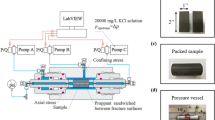Abstract
Productivity in fractured wells typically declines when severe proppant embedment shrinks the fracture aperture and creates conductivity clogging fines. However, the mechanisms linking embedment to decline are poorly characterized. In the absence of this understanding, very few models take proppant embedment into account when predicting production decline. We developed new experimental techniques to characterize proppant embedment mechanisms and properties and combined these results with analytical analysis to quantify stress-dependent elastic and plastic deformation, as well as time-dependent creep deformation. We developed two novel experimental setups to tease apart the elastic, plastic, and creep deformation curves. A constant displacement vs. measured load embedment test generated the elastic and plastic data, and the constant load vs. measured displacement embedment test generated creep data. Results show that plastic and creep deformation dominated proppant embedment in shale, while the elastic deformation component is insignificant.

















Similar content being viewed by others
Abbreviations
- \(\Delta V\) :
-
Differential fluid volume
- \(h\) :
-
Invaded depth
- \(A\) :
-
Surface area
- \(\phi\) :
-
Porosity
- \(a\) :
-
Contact radius of indenter
- \(R\) :
-
Indenter radius
- \(h_{{\text{c}}}\) :
-
Contact depth
- \(F\) :
-
Force
- \(P\) :
-
Applied load
- \(\mu\) :
-
Shear modulus
- \(\nu\) :
-
Poisson’s ratio
- \(S\) :
-
Stiffness
- \(E\) :
-
Elastic modulus
- \(E_{{\text{r}}}\) :
-
Reduced modulus
- \(\sigma_{{{\text{ind}}}}\) :
-
Indentation stress
- \(\varepsilon_{ind}\) :
-
Indentation strain
- \(\varepsilon_{{\text{t}}} , \varepsilon_{{\text{e}}} , \;\varepsilon_{{\text{p}}} \;{\text{and}}\; \varepsilon_{{\text{c}}}\) :
-
Strain of elastic, plastic, and creep, respectively
- \(t\) :
-
Time
- \(K, \;m, \;C,\;n, \;{\text{and}}\; \omega\) :
-
Experimental fitting parameter
References
Alagoz E (2020) Interaction of fracturing fluids with shales: proppant embedment mechanisms. MS Thesis, The University of Texas at Austin.
Alramahi B, Sundberg MI (2012) Proppant embedment and conductivity of hydraulic fractures in shales. In: ARMA Paper#12–291, 46th US Rock Mechanics/Geomechanics Symposium held in Chicago, IL, USA, 24–27 June
Corapcioglu H, Miskimins JL, Prasad M (2014) Fracturing fluid effects on Young's modulus and embedment in the niobrara formation. In: Paper SPE-170835-MS presented at the SPE Annual Technical Conference and Exhibition held in Amsterdam, The Netherlands, 27–29 October 2014
Economides MJ, Nolte KG (1989) Reservoir stimulation, 2nd edn. Prentice Hall, Houston
Guo J, Liu Y (2012) Modeling of proppant embedment: elastic deformation and creep deformation. In: Paper SPE 157449 presented at SPE International Production and Operations Conference and Exhibition, Doha, Qatar, 14–16 May 2012.
Hertz H (1863) Miscellaneous papers, ed. Jones and Schott, London
Huang J, Safari R, Perez O, Fragachan EF (2019) Reservoir depletion-induced proppant embedment and dynamic fracture closure. In: Paper SPE 195135-MS presented at the SPE Middle East Oil and Gas Show and Conference, Manama, Bahrein, 18–21 March 2019
Lacy LL, Rickards AR, Syed AA (1997) Embedment and fracture conductivity in soft formations associated with hec, borate and water-based fracture designs. In: Paper SPE38590-MS presented at the SPE Annual Technical Conference and Exhibition, San Antonio, Texas, 5–8 October
Lacy LL, Rickards AR, Bilden DM (1998) Fracture aperture and embedment testing in soft reservoir sandstone. SPE Drill Complet 13(1):25–29
Meyer E (1908) Contribution to the knowledge of hardness and hardness testing. Zeitschrift Des Vereines Deutscher Ingenieure 52:740–835
Pharr G, Oliver W, Brotzen F (1992) On the generality of the relationship among contact stiffness, contact area, and elastic modulus during indentation. J Mater Res 7(3):613–617. https://doi.org/10.1557/JMR.1992.0613
Reinicke A, Legarth B, Zimmermann G, Huenges E, Dresenn G (2006) Hydraulic fracturing and formation damage in a sedimentary geothermal reservoir. In: ENGINE–Enhanced Geothermal Innovative Network for Europe Workshop 3, stimulation of reservoir and microseismicity, Kartause Ittingen, Zürich, 29, VI–1.VII, Switzerland
Reinicke A, Rybacki E, Stanchits S, Huenges E, Dresenn G (2010) Hydraulic fracturing stimulation techniques and formation damage mechanisms—Implications from laboratory testing of tight sandstone—proppant systems. Chem Erde 70:107–117
Sato K, Ichikawa M (1998) Post-Frac analysis indicating multiple fractures created in a volcanic formation. In: Paper Society of Petroleum Engineers presented at the SPE India Oil and Gas Conference and Exhibition, 17–19 February 1998, New Delhi, India. SPE 39513-MS
Sneddon IN (1965) The relation between load and penetration in the axisymmetric boussinesq problem for a punch of arbitrary profile. Int J Eng Sci 3(1):47–57. https://doi.org/10.1016/0020-7225(65)90019-4
Tabor D (1951) Hardness of metals. Clarendon Press, Oxford
Terracina JM, Turner JM, Collins DH, Spillars SE (2010) Proppant selection and its effect on the results of fracturing treatments performed in shale formations. In: Paper Society of Petroleum Engineers presented at the Annual Technical Conference and Exhibition, 19–22 September, Florence, Italy. SPE 135502
Volk, LJ, Clarence JR, Herbert BC, Judy SS (1981) Embedment of high strength proppant into low-permeability reservoir rock. In: Paper SPE/DOE 9867 presented at the 1981 SPEIDOE Low Permeability Symposium, Denver, Colorado, 27–29 May
Acknowledgements
The authors gratefully acknowledge BP for providing funding for this work and the Utica shale samples.
Author information
Authors and Affiliations
Corresponding author
Additional information
Publisher's Note
Springer Nature remains neutral with regard to jurisdictional claims in published maps and institutional affiliations.
Rights and permissions
About this article
Cite this article
Alagoz, E., Wang, H., Russell, R.T. et al. New Experimental Methods to Study Proppant Embedment in Shales. Rock Mech Rock Eng 55, 2571–2580 (2022). https://doi.org/10.1007/s00603-021-02646-1
Received:
Accepted:
Published:
Issue Date:
DOI: https://doi.org/10.1007/s00603-021-02646-1




